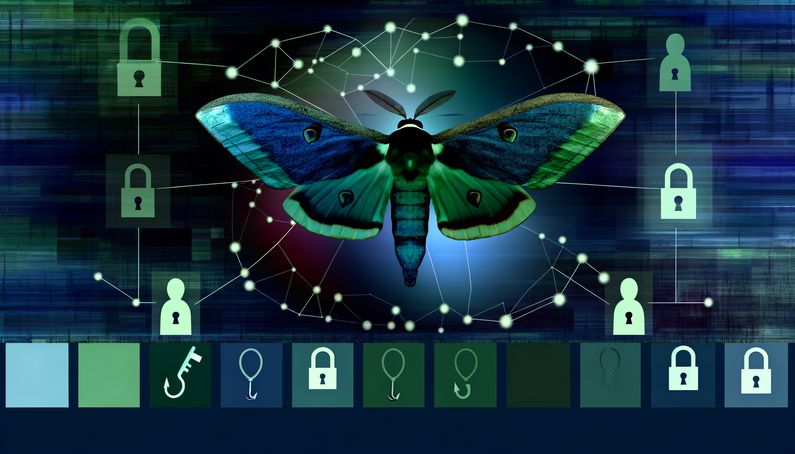
The Luna Moth Group: A New Era of Cyber Threats
The Luna Moth group, also known as the Silent Ransom Group (SRG), has become notorious for its innovative use of callback phishing and IT help desk impersonation to infiltrate organizations. This sophisticated form of social engineering combines traditional phishing with vishing, creating a potent threat that bypasses conventional security measures. By exploiting human psychology, the attackers craft scenarios that induce urgency and fear, prompting victims to call fake IT support numbers where they are manipulated into granting system access. This method not only circumvents email filters but also leverages legitimate Remote Monitoring and Management (RMM) tools to maintain a facade of authenticity (BleepingComputer). The Luna Moth group has refined these tactics, posing as IT personnel and using domains that mimic legitimate companies to deceive victims (EclecticIQ).
The Art of Deception: Callback Phishing and IT Help Desk Impersonation
Evolution of Callback Phishing Techniques
Callback phishing has emerged as a sophisticated hybrid social engineering technique that combines elements of traditional phishing and vishing (voice phishing). This method has been notably employed by the Luna Moth group, also known as the Silent Ransom Group (SRG), to deceive victims into compromising their own systems. Unlike conventional phishing, which typically involves malicious links or attachments, callback phishing relies on creating a sense of urgency and confusion through fake subscription alerts or IT issues. Victims are prompted to call a provided phone number, where attackers impersonate IT support staff. This approach not only bypasses email security filters but also exploits human psychology, making it a potent tool for cybercriminals (BleepingComputer).
Impersonation Tactics and Their Impact
The Luna Moth group has refined the art of impersonation, posing as IT help desk personnel to gain victims’ trust. This tactic involves setting up fake IT support websites with domain names that mimic legitimate companies, such as [company_name]-helpdesk.com. By doing so, they create a semblance of authenticity, making it challenging for victims to discern the deception. Once contact is established, the attackers guide victims to install Remote Monitoring and Management (RMM) software, granting them unauthorized access to the victims’ systems. This method is particularly effective because the tools used, such as Syncro, SuperOps, and Zoho Assist, are legitimate and digitally signed, reducing the likelihood of detection by security software (EclecticIQ).
Psychological Manipulation in Social Engineering
Social engineering is at the core of Luna Moth’s operations, leveraging psychological manipulation to exploit human vulnerabilities. The attackers create scenarios that induce fear or urgency, such as threats of data leaks or account suspensions, compelling victims to act hastily. By masquerading as trusted entities, they lower the victims’ defenses, making them more susceptible to following instructions without skepticism. This manipulation is further enhanced by the attackers’ ability to maintain a calm and professional demeanor during interactions, reinforcing the illusion of legitimacy. The success of these tactics underscores the need for organizations to educate employees about the psychological aspects of social engineering and the importance of verifying the authenticity of unsolicited communications (Social Engineer).
Technological Exploitation and RMM Tools
The use of Remote Monitoring and Management (RMM) tools in Luna Moth’s campaigns highlights the dual-use nature of technology. While these tools are essential for legitimate IT support operations, they can be weaponized by cybercriminals to gain unauthorized access to systems. Imagine RMM tools as a master key that can open any door in a building. Once installed, these tools provide attackers with hands-on keyboard access, enabling them to navigate the victim’s network, search for sensitive data, and exfiltrate it to attacker-controlled infrastructure. The attackers often use tools like WinSCP and Rclone to transfer stolen data securely. This exploitation of legitimate software poses a significant challenge for cybersecurity defenses, as traditional security measures may not flag these tools as malicious (Heimdal Security).
Mitigation Strategies and Organizational Preparedness
To combat the threat posed by callback phishing and IT help desk impersonation, organizations must adopt a multi-faceted approach to cybersecurity. This includes implementing robust email filtering systems to detect and block phishing attempts, as well as maintaining an up-to-date blocklist of known malicious domains and IP addresses. Additionally, organizations should restrict the execution of RMM tools that are not essential to their operations, reducing the risk of unauthorized access. Employee training is also crucial, focusing on raising awareness about social engineering tactics and encouraging skepticism towards unsolicited communications. By fostering a culture of vigilance and implementing comprehensive security measures, organizations can better protect themselves against the evolving threat landscape (Infosecurity Magazine).
Legal and Financial Sector Vulnerabilities
The legal and financial sectors have been prime targets for Luna Moth’s extortion campaigns, owing to the sensitive nature of the data they handle. These industries are particularly vulnerable due to the high value of the information stored within their networks, which can include client data, financial records, and intellectual property. The attackers exploit this by threatening to publicly leak stolen data unless a ransom is paid, with demands ranging from one to eight million USD. The financial impact of these attacks is significant, not only in terms of ransom payments but also in potential reputational damage and regulatory penalties. Organizations within these sectors must prioritize cybersecurity investments and collaborate with industry peers to share threat intelligence and best practices (Unit 42).
The Role of Domain Registration in Deception
Domain registration plays a critical role in Luna Moth’s deception strategy, with the group reportedly registering at least 37 domains through GoDaddy to support their campaigns. These domains are designed to impersonate IT helpdesk or support portals for major U.S. law firms and financial services firms, using typosquatted patterns to appear legitimate. This tactic not only aids in the initial deception but also complicates efforts to track and block malicious domains. Organizations can mitigate this risk by monitoring domain registrations related to their brand and reporting suspicious activity to domain registrars. Additionally, implementing Domain-based Message Authentication, Reporting & Conformance (DMARC) can help prevent domain spoofing and protect against phishing attacks (SOCRadar® Cyber Intelligence Inc.).
Expanding Scope and Future Threats
The scope of Luna Moth’s operations continues to expand, with the group targeting businesses across multiple sectors, including retail, healthcare, and technology. This diversification indicates a strategic shift towards exploiting a broader range of industries, each with its unique vulnerabilities and data assets. As the group refines its tactics and explores new avenues for exploitation, organizations must remain vigilant and proactive in their cybersecurity efforts. This includes staying informed about emerging threats, conducting regular security assessments, and fostering a culture of continuous improvement in cybersecurity practices. By doing so, organizations can better anticipate and respond to the evolving threat landscape posed by sophisticated cybercriminal groups like Luna Moth (FBI).
Final Thoughts
The Luna Moth group’s operations underscore the evolving nature of cyber threats, where psychological manipulation and technological exploitation converge. Their use of callback phishing and IT help desk impersonation highlights the need for organizations to adopt comprehensive cybersecurity strategies. This includes employee training on social engineering tactics and the implementation of robust security measures to detect and block phishing attempts. As the group expands its scope, targeting diverse sectors such as retail and healthcare, the importance of vigilance and proactive defense becomes paramount. Organizations must stay informed about emerging threats and continuously improve their cybersecurity practices to mitigate risks (Infosecurity Magazine).
References
- Callback phishing attacks evolve their social engineering tactics. (2024). BleepingComputer. https://www.bleepingcomputer.com/news/security/callback-phishing-attacks-evolve-their-social-engineering-tactics/
- Luna Moth extortion hackers pose as IT help desks to breach US firms. (2024). EclecticIQ. https://www.bleepingcomputer.com/news/security/luna-moth-extortion-hackers-pose-as-it-help-desks-to-breach-us-firms/
- The rising threat of callback phishing. (2024). Social Engineer. https://www.social-engineer.com/the-rising-threat-of-callback-phishing/
- Luna Moth is a new tool used by hackers to break into organizations. (2024). Heimdal Security. https://heimdalsecurity.com/blog/luna-moth-is-a-new-tool-used-by-hackers-to-break-into-organizations/
- Luna Moth phishing target multiple sectors. (2024). Infosecurity Magazine. https://www.infosecurity-magazine.com/news/luna-moth-phishing-target-multiple/
- A new rising social engineering trend: Callback phishing. (2024). SOCRadar® Cyber Intelligence Inc. https://socradar.io/a-new-rising-social-engineering-trend-callback-phishing/
- Luna Moth callback phishing. (2024). Unit 42. https://unit42.paloaltonetworks.com/luna-moth-callback-phishing/



